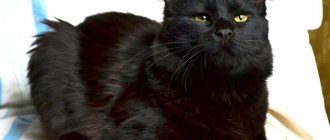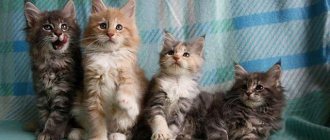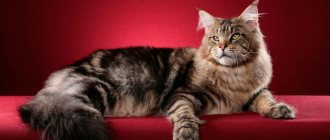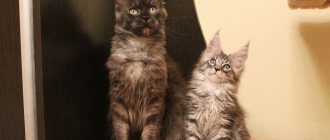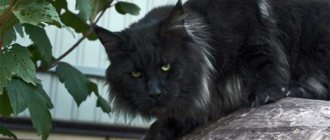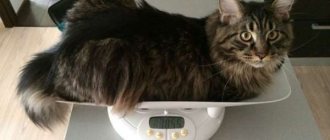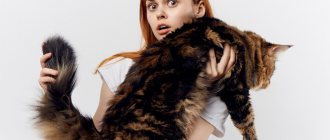16417Marina Kharlova
1
Maine Coon and an ordinary cat have many differences, however, the market is filled with a huge number of kittens that are passed off as real purebreds. In fact, at best it will turn out to be a mestizo - a cross between a Maine Coon and an ordinary cat, or it will even turn out that the Maine Coon was not even close to that.
In order not to make a mistake in choosing, you need to clearly know the characteristics characteristic of this breed. Before you go for the long-awaited kitten, it is worth studying in advance how the Maine Coon and an ordinary cat differ.
The handsome Maine Coons, with their appearance and large size, are more reminiscent of a real wild animal than a pet, due to which the demand for representatives of the breed has been steadily growing in the last decade.
© shutterstock
Choice of kitten and price
When choosing a kitten, it is important to pay attention not only to the baby and parents, but also to the breeder and his nursery, to the environment in which the animals are kept.
If the cats live clean, look healthy, there is no overcrowding of 5 tails per square meter, in general, after the visit there is a pleasant impression, then this is wonderful. If it seemed that you visited a farm, then most likely you came to the wrong address. If it seemed that you visited a farm, then most likely you came to the wrong address.
The kitten must be healthy. You can list a lot of signs by which this is determined, but first of all, this is the condition of the coat, eyes, nose and ears. The coat should be soft and shiny. There should be no discharge on the face, and the butt should be clean. Your baby should smell nice like a cat baby.
The kitten should be picked up no earlier than 2.5-3 months. A one and a half month old baby is a creature that needs maternal care, and not a new family. At 3-4 months, the kitten is already more or less independent, accustomed to all hygiene procedures, and socialized. His individuality and the beginning of the formation of his own character are already noticeable. In addition, at this age, one of the most dangerous age stages in terms of health has already passed. The baby will easily enter the new home.
If a breeder gives away kittens under the age of 2 months, you should seriously think about purchasing them. It becomes more difficult to feed and raise babies, so they want to get rid of them early, without thinking about the consequences. Most likely, these kittens are not vaccinated. And they are definitely not ready to say goodbye to their mother, either physically or psychologically.
How to distinguish a Maine Coon kitten
Adult Maine Coons differ from ordinary domestic cats and many other breeds primarily in size and, of course, appearance features. It is much more difficult to determine the breed in kittens, but, nevertheless, it is possible even for a layman.
Maine Coon kittens already weigh 120-170 grams at birth. (for comparison: regular kittens 80-120 gr.). At 3 months, babies have already gained significant size and weigh from 1.5 to 2.3 kg. By 4 months, their weight reaches 3 kg or more. That is, in size they can be compared to a small domestic cat.
Maine Coon babies are characterized by massive fluffy paws and a relatively long, powerful, well-furred tail. Tufts of fur begin to grow between the toes.
As for purebredness, which is often mentioned in advertisements, it is determined solely by pedigree. In the absence of such, it is difficult to distinguish an unexpressed mestizo at a young age. A general idea of what the kittens will look like can be formed by assessing the appearance of the parents.
“When will his tassels grow?” future owners often ask when choosing a kitten. If a kitten does not have clearly defined tufts of hair by 3 months, then they will never grow, even if the seller (not the breeder) assures otherwise. It is worth recalling that tassels on the ears are desirable, but not required, according to the standard.
What else to pay attention to
There are additional ways to protect yourself from purchasing an ordinary cat disguised as a purebred Maine Coon. They relate not to the appearance and characteristics of the kitten itself, but to the conditions of its sale and execution of the transaction.
An experienced breeder will not place a kitten under 3 months of age into the wrong hands. By this period, all vaccinations and treatment against parasites must be completed. At this age, the pet is already completely ready for socialization.
A purebred Maine Coon, unlike an ordinary cat or mixed breed, must have documents confirming the breed.
In them, experts describe the advantages of a cat and place it in one of three groups:
- The highest level is the Show class, which implies exhibition qualities and value for breeding.
- Breed group with good genetic characteristics and prospects for breeding work.
- Pet cats. Maine Coons fall into this category, the owners of which do not intend to go to exhibitions and raise kittens.
The Maine Coon is a huge fluffy cat with tufted ears, a long fluffy tail and powerful paws. It is impossible to confuse it during adulthood with another breed. But in childhood, all kittens seem the same, and their spontaneous purchase often turns into a regular lottery. Therefore, the main guarantee that your pet belongs to a certain breed will be the presence of a pedigree.
Why does a Maine Coon kitten not gain weight?
As soon as the owner notices a discrepancy with the body weight table, it is worth seeking help from veterinarians. Insufficient recruitment can be caused by a number of reasons:
- lack of vitamins;
- non-compliance with energy balance;
- the kitten is stressed;
- genetic or acquired diseases of the kitten.
If a cat gives birth to small newborn kittens, they may develop more slowly and take longer to reach the required weight and body size. Larger ones develop much faster than their smaller peers. Small size is often due to genetics.
Sometimes there are situations when just small kittens are born. This can be called a genetic failure; it cannot be corrected. You should not give your kitten any supplements that affect growth on your own. All drugs should be prescribed only by a veterinarian and if there are compelling reasons for their use.
Feeding
In the first months of life, kittens need milk in large quantities; the mixture can be purchased at pet stores.
Goat milk is allowed. In the first month, the kitten should eat about six times a day, in small portions.
It is better to ask the cattery what kind of food the cats eat and stick to that diet. Grown-up kittens are fed meat and vegetables.
Animals under 6 months of age need to be fed four times a day. The diet includes vegetables, cottage cheese and whey.
Adult cats - from one year old - are fed with specialized food:
- "Royal Canin" for Maine Coons.
- "Bosch Sanabelle Grande" for large breeds.
Vitamins
The best set of vitamins for cats of this breed is found in fish oil, eggs, dairy products, and tomatoes. For healthy skin, give cabbage, liver, and yeast products. Vegetables and fruits will boost your cat's immunity. With the help of natural vitamins, you can balance your pet’s diet so that he gets the maximum benefit from his food.
But to maintain health, you also need special products that contain zinc, copper, manganese, and iron. Pet stores offer vitamin complexes with taurine. They improve vision and digestion. For good skin and coat condition, vitamin complexes with biotin are given. The animal also needs calcium, vitamin B6, A, B and D.
How to distinguish a Maine Coon by external data
Without practical experience, it is difficult to distinguish a purebred cat from a Maine Coon mestizo, so it is better to seek help from a specialist who knows the little-known nuances of the breed. But there are a number of obvious signs for comparing kittens with and without pedigree.
These include the length and color of the coat, eye color, size, weight of the baby and other developmental features of the animal.
By length, quality and color of coat
A Maine Coon kitten's fur is soft and pleasant to the touch. There are no adult attributes in the form of a fluffy mane and panties on the hind legs yet, but even in childhood, the cover on these parts of the body is more pronounced than in ordinary cats.
It is also possible to determine whether a Maine Coon is a real Maine Coon or not by the color of a kitten’s fur at a young age. Colors unacceptable for these animals: chocolate and cinnamon (cinnamon), rich lilac colors and lightened shade of coastal sea sand (fawn).
This breed does not have color-point or acromelanic colors.
By weight and size
The next distinguishing feature is the difference in weight and size of an ordinary cat and a purebred Maine Coon.
| Boys (kg) | Girls (kg) | |
| Birth | 0,12-0,16 | 0,1-0,14 |
| 1 month | 0,65-0,75 | 0,55-0,7 |
| 2 months | 1,2-1,5 | 1-1,4 |
| 3 months | 2,8-3,7 | 1,6-2,4 |
| 4 months | 3,1-3,9 | 2,5-3,6 |
| 5 months | 3,3-4,2 | 2,8-4 |
By the age of three months, the body weight of an ordinary cat, in comparison with a Maine Coon, is approximately 2 times less.
By physique
The following characteristics will help determine the characteristics of the breed characteristics of Maine Coon kittens by constitution (structure):
- The body is long, elongated, rectangular in shape, the front and hind limbs are of the same height.
- The paws (especially the front ones) are powerful and straight.
- The long, even tail reaches the shoulder blades.
According to general indicators, a Maine Coon next to an ordinary cat of the same age looks like Gulliver in the land of Lilliput.
If you have doubts about the purebred kitten, you need to pay attention to the animal’s head - a real Maine Coon has the following external signs:
- The ears are large, located almost vertically, with a slight tilt forward.
- Box-shaped muzzle with high cheekbones.
- In profile, a “hall” is clearly visible between the bridge of the nose and the forehead, which can be formed with varying degrees of bending.
By the eyes
The Maine Coon's eyes are large and slanted. There are no specific requirements for the color of the iris - it can be green, amber, golden, blue, even heterochromia (eyes of different colors) is allowed.
By growth and development rate
At three months of age, you can easily distinguish a Maine Coon by its size - it will be 2 times larger than a regular cat. By 6 months, the cat will be the same size and weight as a normal adult cat.
If we are talking about mestizos, then the problem becomes more complicated. Depending on the parental qualities inherited, such cats sometimes grow as actively as their purebred relatives.
How is it different from the usual one?
The Maine Coon has a number of its own characteristics that distinguish it from its ordinary relative. The appearance of this cat is more similar to that of the wild. Their muzzle vaguely resembles the muzzle of a panther; their look is quite predatory and confident. This cat is respectable, large, and often has a rather stern look. At the same time, the eyes of a wild cat are slightly slanted, which is not the case with a domestic pet: its eyes are round.
At first glance, it immediately seems that this is a cat on an enlarged scale. Despite the fact that female Maine Coons are smaller than males, the length of the cat can reach about 1 meter. The average weight is 8-9 kg, neutered cats weigh up to 10-12 kg.
Compared to an ordinary cat, the Maine Coon has an elongated muzzle, with its lower part moving forward. The chin itself is located in a single line with the nose, it is quite powerful and well developed. Unlike domestic cats, the Maine Coon looks like an athlete: individuals of this breed are characterized by a strong and even muscular physique. Their skeleton is large, their paws are more powerful, wider and longer.
The Maine Coon can boast of thick hair, and it is not just dense and thick, but very soft. This cat has a fluffy frill collar that covers not only his neck, but also his chest. Longer hair grows on the tail, hind legs and belly. In addition, it is also present between the claws.
The position of the ears is also different: in a Maine Coon they are located higher than in a regular cat. The ears themselves are wider and have long tufts of hair on the inside, which are located horizontally to the floor. The key difference between a large cat is the presence of tufts on the ears, characteristic of a lynx.
It is difficult to distinguish a Maine Coon from a mixed breed. Experts can recognize this by examining the animal’s face. They note that in the purebred Maine coon cat, the box formed by means of whisker pads is geometrically flawless. In addition, they are distinguished by a more distinct transition to the zygomatic part. The weight of the mestizo also differs: as a rule, mature individuals do not exceed 7 kg in weight.
Comparison of mestizos and purebred kittens
6 interesting reasons why you should get a Maine Coon
To compare the characteristics of purebred representatives and half-bloods, it is worth considering the following table.
| Thoroughbred | Metis | |
| Weight at 6 months | 3-6 kg. | Depending on the mixture. On average from 2-4 kg. |
| Adult weight | Up to 10 kg | Up to 7 kg. |
| Dimensions | Large | Medium sized animal |
| External features | Characteristic tassels on the ears | In most cases, there are no tassels. Many half-breeds most closely resemble ordinary yard cats |
| Character | Headstrong | Attached to their owners |
| Nutrition | Matches. Enjoy eating food, meat, fish and other foods | Matches. Enjoy eating food, meat, fish and other foods |
Opportunity to participate in exhibitions
Mixed breeds are not allowed to participate in international exhibitions of purebred animals. They do not have the necessary documents confirming their pedigree, and there are also differences in appearance from purebred pets.
In this case, mixed breeds can participate in events where outbred animals are assessed. Pets older than 10 months are allowed to participate in such exhibitions. In this case, the animal must be prepared for the event. Grooming and purchasing the necessary accessories will be required.
Maine Coon kitten size
Maine raccoon cats are born quite large in size and weigh an order of magnitude more than kittens of other breeds. For example, if the weight of a newborn Persian breed varies between 125-150 g, then a Maine Coon kitten is born weighing 125-170 g. According to average statistical data, the weight of a newborn Maine Coon is significantly influenced by the number of kittens in the litter, therefore , the fewer kittens, the greater their weight.
The rate of growth processes and weight gain in a newborn directly depends on its gender, as well as the characteristics of the parental genotype. As a rule, kittens born from a physically healthy and massive cat grow and develop faster. The kitten's growth can be negatively affected by the cat's use of hormonal drugs that can provoke a pronounced endocrine imbalance.
In order for a Maine Coon kitten to gain height and weight correctly, it is necessary to comply with a number of requirements, including ensuring optimal sanitary and hygienic conditions in the place where the animals live, preventing stressful situations in the form of noise and temperature changes, and proper and balanced nutrition for the nursing cat and kittens.
The suckling period lasts from birth until four weeks, and is also characterized by constant and stable growth. In the first ten days, the kitten’s body weight doubles, and by a month the weight becomes approximately four times greater.
Possible offspring
No significant changes are expected in terms of coat color. Most domestic cats without admixture from other breeds have the colors acceptable in Maine Coon Cats. But genetics suggests unexpected results. Mutations, such as polydactyly, which is common in coons, are likely to affect part of the litter. Coat color and pattern are inherited according to established laws.
Useful to read: Recommendations for choosing a Maine Coon
Science knows interesting facts about eye color. Usually it does not depend on the color of the coat, but blue pigment accompanies color-point colors (Siamese cats), and less often white. In practice, if you cross a green-eyed coon with a blue-eyed female, the offspring will most likely take after the father for this trait. This happens because green is dominant to blue. When white kittens are born, the situation may change.
All Maine Coon cats have medium-length fur. If you cross a representative with a smooth cat, the litter will be short-haired. The birth of kittens with long hair is possible if there are two long-haired parents.
Character and behavior are unpredictable in this combination. Street cats are more aggressive by nature, this is dictated by the laws of survival in difficult conditions. Pedigree cats are softer, because purposeful work has been carried out for decades to consolidate behavior that is comfortable for humans.
Weight and body structure are also difficult to calculate, but most half-breeds are distinguished by their impressive dimensions, although they are inferior to their purebred parents. Kittens are born with different characteristics, some are smaller, some are larger.
Metis requires the same careful attention as a purebred animal. A balanced diet, walks, and the love of the owner are mandatory criteria for the happiness of any pet.
Breed standards
The standards were introduced to control the breeding work of breeders, since the purity of the breed can only be preserved if the parents meet the criteria for pure breeding in all key parameters.
The Maine Coon breed has the following strict standards:
- the size of males and females should differ significantly (males are larger);
- the body is large with a wide chest;
- the paws are muscular and rounded, with tufts of hair between the toes;
- the wide tail reaches the shoulder;
- the fur on the tail flows;
- large square skull;
- the profile of the muzzle is curved;
- the eyes are large, slightly slanted, widely set;
- eye color is harmonious with coat color;
- the ears are wide at the base, tapering to the tips with tassels and abundant feathering, set close together;
- the coat is dense, waterproof, and has different lengths (longer on the belly and hind legs);
- undercoat without main hair on the belly and “pants”;
- the mane is optional, but adds points for the overall appearance of the animal.
Maine Coon individuals grow up to the age of three years, but after the first year of life they already look like adults, weight gain and growth slow down noticeably, and sometimes jumps in development can be observed. Participation in exhibitions is allowed from the age of three months, but the awarding of titles begins at ten months.
There are three rating systems for this breed.
WCF (Russia) – the animal is examined at an open exhibition in the presence of the owner. One rating is given per day. Evaluation criteria: body that meets the standard is estimated at 35 points, head - 40 points, coat color and quality - 25 points, eye color - 5 points, general appearance - 5 points. They are disqualified for hybrid colors: chocolate, lilac, Siamese, etc., as well as for long hair on the belly.
Breed standard
Color: Chocolate, cinnamon and corresponding weakened colors (lilac and fawn) are not accepted in any combination (including tabby, bicolor, tricolor); acromelanic colors are also not recognized. All other colors are recognized.
Head: The head is large, massive, straight, sharp in outline. High cheekbones, medium length nose. The muzzle is massive, angular, clearly defined. The chin is strong, massive, in line with the nose and upper lip. The profile is curved.
Coat: The undercoat is soft and fine, covered with coarser, dense hair. The thick, free-flowing, water-repellent topcoat extends to the back, sides and top of the tail. The lower part of the body and the inner surface of the hind legs do not have integumentary hair. A frill is preferred, but a full collar is not necessary.
Body: Large to very large cat, muscular, elongated and broad-boned rectangular body. The muscular neck is of medium length, the chest is wide. The limbs are of medium length, strong, muscular, the paws are large, round, with tufts of hair between the toes. The tail is long, at least to the shoulder, wide at the base, tapering to a pointed tip, covered with flowing hair.
Ears: The ears are very large, wide at the base, pointing sharply, set high, almost vertically. The distance between the ears is no more than the width of one ear. Brushes protrude beyond the edge of the ears; tassels are desirable.
Eyes: The eyes are large, oval, set wide and at a slight angle; the color should be uniform and harmonize with the color of the coat.
All systems of standards for assessing Maine Coons are uniform in the criteria of origin and temperament: parents must be titled, the character must be friendly and balanced.
Crossbreeding
Mixed breeds are animals whose parents belong to different breeds. They are the starting material for selection for the purpose of breeding new breeds. Although, it can be assumed that both breeds have common features.
Interbreeding of Maine Coons is undesirable, as the risks of various diseases increase. Mestizos may be attractive in appearance and have pleasant manners.
However, even with significant compliance with the breed standard, they are not considered its representatives. They are usually no larger than the average Maine Coon.
Description
In specialized nurseries it is prohibited to buy culled individuals for breeding, but they can be purchased as a pet. The main condition when purchasing such a baby is mandatory castration or sterilization of the kitten in the future. A mixed breed cat and a purebred cat are completely different.
The appearance of a half-breed can be very diverse, it all depends on what genes were passed on from the parents.
A purebred breed has the following qualities:
- goodwill;
- ease of communication with people and other cats;
- devotion;
- lack of aggression;
- loyalty;
- prudence.
When mating with an ordinary cat, the listed traits change and sometimes disappear altogether. It is quite simple to distinguish a purebred Maine Coon: representatives of this breed have slanted eyes, wide cheekbones, an elongated head shape, tufts on the ears, an unusually fluffy and long tail, and massive paws. Babies at 3 months weigh at least 2.5 kg (an ordinary cat at this age weighs no more than 1 kg). Adult males reach a length of about 1 meter and a weight of about 11 kg, with a height at the withers of up to 40 cm (females are somewhat smaller).
Why are they similar
As the name suggests, the Siberian breed originated in a harsh climate. Her ancestors were brought to Siberia from the European part of the continent. The conditions of the region caused a change in the genotype of cats. They became larger, more powerful, grew thick hair, and learned to survive in the cold.
The situation is similar with coons. Although it is not known for certain how they appeared in America, the climate and living conditions are very similar. The standard Maine Coon has the same length of hair, tufts on the ears, and is significantly larger in size than other domesticated relatives. The rich edge of the tail, its size, mane, decorating the hair on the paws are additional similarities.
If the Maine Coon is already a fully formed breed, then cats from Europe have been very diverse for a long time. This is explained by the fact that cat breeders for a long time could not come to a consensus on the characteristics of the livestock. Moreover, the breed is young.
Description of the breed
The Maine Coon is often called a wild cat for its menacing and majestic appearance. Felinologists are still arguing about the history of the origin of these animals, which differ from ordinary cats in their size and appearance. It is generally accepted that Maine Coons first appeared in the northwestern United States, in Maine, which partly explains the name of the breed.
The Maine Coon is called the Maine raccoon cat; it appeared at the end of the 19th century and is a long-haired breed of cat. Its life expectancy is on average about 12-15 years. Height at the withers varies from 25 to 45 cm, and the length from the tip of the nose to the tip of the tail in some cases reaches 1 m or more. There are cases when the length of males reached 135 cm.
The Maine Coon has a large head, massive and high legs, and a powerful chest. It cannot be confused with ordinary cats due to its unusual appearance. The coon's ears have tufts, like those of a lynx. In addition, he has prominent cheekbones and an oval head shape, elongated upward. There are long horizontal hairs in the ears, and there are tassels between the claws of the paws.
Maine Coon eyes are different from the eyes of ordinary cats. They are not round, but rather oval, seeming half-closed. Perhaps this is why the animal’s gaze is imperious or even regal. Such a pet is always self-confident; its weight can reach 13-15 kg. Kittens grow very quickly, acquiring all the external characteristics of the breed by 3 months.
The Maine raccoon cat with well-developed muscles is very graceful; unlike outbred cats, it has a very long and fluffy tail. As for the coat, it is incredibly thick and dense, but at the same time silky. The color of the animal can be different, for example, plain smoky, spotted or brindle.
The Maine Coon never makes the heart-rending sounds that barn cats are famous for. Whatever he needs, he will melodiously say about it, purring his request to the owner or mistress of the home.
Characteristic signs
Maine Coons have a rather specific appearance, with clear differences from the appearance of a natural mongrel cat.
Distinctive features of a Maine Coon pet:
- Large, triangular ears set almost at right angles, pointing upward rather than forward. The tip of the ear is decorated with a noticeable tassel - this is the main distinguishing feature of the appearance of a Maine Coon cat.
- The head is slightly elongated. The muzzle is large, with high cheekbones and, when viewed from the front, has a square shape.
- The eyes are more fox than cat-like: slanted, not round, but almond-shaped.
- The paws are large and heavy – this is another main distinguishing feature of the breed. There is fluff growing between the fingers.
- The tail is long, 2 times longer than that of ordinary cats.
- The coat is of medium length, but dense and voluminous.
- The body is large. Already at 5 weeks, a Maine Coon weighs the same as a 6-month-old regular pet. And a six-month-old pet looks almost no different from an adult ordinary cat.
- The physique is sinewy and strong. The skeleton is heavy. The chest is wide.
Cat or cat?
To begin with, of course, you need to decide - is it a cat or is it a cat?
In fact, most often people choose a cat and there is an explanation for this. Firstly, they grow larger than cats. Secondly, cats have a softer character. This does not mean that cats are angry and aggressive, it’s just that cats are calmer and after three to four years they prefer to lazily lie on the sofa as a beautiful decoration.
Cats, on the other hand, are active, playful and need physical activity throughout their entire lives. When choosing the sex of an animal, you should take into account what you want to get - a beautiful couch potato or an active toy.
In addition, according to some beliefs, cats take energy, and cats, on the contrary, heal. Here, of course, it is difficult to refute or, conversely, to assert, since these are just beliefs without any evidence. Although, if a person is superstitious, perhaps this argument will play a decisive role in choosing the sex of the furry.
Head shape
Experts say that one of the main distinguishing features of a real Maine Coon is the geometrically correct shape of the lower part of the muzzle. Due to its characteristic symmetry, it is a square. A powerful chin gives the muzzle a brutal and somewhat menacing appearance. Maine Coons are given additional severity by the serious look of their slanted eyes.
Neat ears of a regular triangular shape, pointed at the tips and equipped with tassels, are also a characteristic feature of the breed. They give cats a lynx-like appearance. The base of the auricle is always wide, the transition to the muzzle is clearly marked.
Features and risks of breeding Maine Coon mixes
- In interbreeding, the breed's traits degenerate very quickly, and it is impossible to achieve a stable result. Uncontrolled matings with representatives of other breeds can lead to the appearance of genetic deformities, and this may not appear immediately, but only in subsequent generations of such mestizos.
- If a Maine Coon cat is paired with a female of a different breed, there is a high risk that the babies will be born too large; perhaps their mother simply will not be able to give birth. In this case, it is better not to risk the life and health of your pet.
- With a high probability, mestizos may not inherit the main qualities for which representatives of this breed are valued: friendliness, devotion to people, sociability.
- If a grown-up mestizo does not look exactly like a Maine Coon, there is often a high chance that he will disappoint the owner, will not live up to his expectations and will end up on the street.
Where do they come from?
It is worth noting that modern veterinarians, dog handlers and felinologists are against non-professional matings between breeds and representatives without documents and permission to breed. This happens not because these specialists are sorry that new species will appear, but because there are more than 60 varieties of cats.
Many of the officially recognized ones are also originally crossbreeds of two breeds, which, as a result of selection, became an independent species. This is how the British and Scottish breeds, Munchkins, and Ukrainian Levkoy were developed.
The work of felinology to improve these breeds continues to this day.
But it also happens that mixed-breed kittens appear in a family where they are not familiar with the methods and conditions of breeding. This often happens if animals of different sexes are in the same room during estrus. Or the owners let the animals go out for a walk during the mating season, which ends in the cat becoming pregnant from an unknown cat.
We invite you to read: Description of the breed and character traits of the Siamese cat
Of course, such situations are an example of irresponsible animal keeping, since they pose a threat to both the pet’s life and its health.
Mixed breeds are also produced by owners who decide to independently experiment with matings between breeds
Mixed breeds are also obtained from owners who decided to independently experiment with matings between breeds, which, in their opinion, produce unusual and beautiful crosses and offspring.
Vaccinations
The first vaccination is given at the age of two months. This is a complex against:
- Viral infections.
- Tracheitis.
- Chlamydia.
- Pailenkopenia.
To prevent the body from being overloaded with vaccines, a special vaccination schedule is prescribed. The first - up to a year.
It is necessary to vaccinate a kitten before three months and after eight months, since from 4 to 7 months, during the period of teeth change, the animal’s immunity will be weakened, and it does not need to be undermined by vaccines. Vaccinations are given only to healthy animals, before which an anthelmintic is given. 10 days before vaccination, the cat is treated against fleas and ticks. The second vaccination occurs along with the rabies vaccination. A doctor must administer the vaccine.
Care
The Maine Coon, like any pet, needs to be carefully looked after and monitored for the pet’s health. A set of simple steps for care:
- Vaccinate once a year against rabies, calcivirosis and other diseases.
- Treat for fleas and ticks.
- Brush about twice a week, more often during shedding periods. Bath several times a month.
- Examine your teeth and gums for tartar buildup or other problems. If necessary, see a veterinarian and add vitamins to the diet.
- Examine your eyes and wipe them daily with a clean piece of cotton wool. If discharge appears, wipe with a weak tea solution. If necessary, contact a specialist.
- Use spacious trays with filler, preferably wood. Keep them clean at all times.
- Communicate and play with the animal more often.
